
Ford Mustang Mach-E. Image source: www.ford.com.
This article delves into Ford Motor (NYSE: F) and its electric vehicle (EV) sales in the U.S. and globally.
Ford Motor began taking EVs seriously in fiscal 2020. Although the company may have experimented with electric vehicles before 2020, that period is not the focus of this article.
As a latecomer to the EV market, Ford Motor’s EV deliveries lag significantly behind Tesla’s. According to the latest figures, Tesla is nearing 2 million productions and deliveries.
In comparison, Ford delivered only 160,000 BEVs as of the end of fiscal year 2024. Let’s take a look.
For other statistics of Ford Motor, you may find more information on these pages:
- Ford global sales and market share,
- Ford sales by vehicle type – BEV, hybrid, and ICE, and
- Ford market share by country – America, China, Europe, etc..
Please use the table of contents to navigate this page.
Table Of Contents
Definitions And Overview
O2. Ford EV Strategy
Types Of EV
A1. Electric Vehicle Types
A2. Conventional Hybrid EV
A3. Plugged-In Hybrid EV
A4. Battery Electric Vehicles
Ford’s EV Roadmap
B1. BEV Roadmap
Global EV Sales
C1. Worldwide EV Sales
C2. Worldwide EV Sales In Percentage
U.S. EV Sales
D1. U.S. EV Sales
D2. U.S. EV Sales In Percentage
U.S. EV Sales By Model
Summary And Reference
S1. Summary
S2. References and Credits
S3. Disclosure
Definitions
To help readers understand the content better, the following terms and glossaries have been provided.
Vehicle Wholesale: According to the annual reports, Ford’s vehicle wholesale includes all Ford and Lincoln badged units (whether produced by Ford or by an unconsolidated affiliate) that are sold to dealerships or others, units manufactured by Ford that are sold to other manufacturers, units distributed by Ford for other manufacturers, and local brand units produced by our China joint venture, Jiangling Motors Corporation, Ltd. (“JMC”), that are sold to dealerships or others.
Vehicles sold to daily rental car companies that are subject to a guaranteed repurchase option (i.e., rental repurchase), as well as other sales of finished vehicles for which the recognition of revenue is deferred (e.g., consignments), are also included in wholesale unit volumes.
Ford’s vehicle wholesale excludes transactions between Ford Blue, Ford Model e, and Ford Pro segments.
Mustang Mach-E: The Ford Mustang Mach-E is an electric SUV manufactured by Ford Motor Company. It was introduced in 2019 and is the first vehicle under the Mustang brand name since the original Mustang was introduced in 1964.
The Mach-E is designed to be a high-performance electric vehicle with a range of up to 300 miles on a single charge and can accelerate from 0 to 60 mph in as little as 3.5 seconds. It also features several advanced safety features and a sleek, modern design that appeals to many consumers.
Ford F-150 Lightning: The Ford F-150 Lightning is an all-electric version of the popular Ford F-150 pickup truck. It features a dual-motor setup that delivers instant torque, impressive acceleration, and a range of up to 300 miles on a single charge.
The truck is designed with practicality in mind, with a spacious and versatile interior and a range of useful features like a built-in power generator and a large front trunk. Overall, the Ford F-150 Lightning is a unique and exciting addition to the electric vehicle market, offering the power and performance drivers expect from a pickup truck and the environmental benefits of an all-electric drivetrain.
E-Transit: Ford’s E-Transit is an all-electric version of the popular Ford Transit cargo van. It has a range of up to 126 miles on a single charge and will be available in multiple configurations to suit various commercial needs.
The E-Transit is designed to be a zero-emissions vehicle, making it an ideal choice for businesses looking to reduce their environmental footprint while still enjoying the performance and functionality of the Transit.
Ford EV Strategy
Ford Motor’s electric vehicle (EV) strategy is centered around a comprehensive and ambitious plan to transition to an electric lifestyle and commercial fleet.
The company is investing $22 billion in electrification through 2025, aiming to lead in areas of strength by electrifying its most iconic products, such as the Mustang, F-150, and Transit.
Key components of Ford’s EV strategy include:
- Electrification of Iconic Models: Ford is electrifying its most popular vehicles, including the Mustang Mach-E, F-150 Lightning, and E-Transit. These models combine performance, capability, and productivity with zero-emissions technology.
- Expansion of EV Offerings: Ford plans to introduce a range of new electric vehicles, including commercial vans and pickup trucks. The company is focusing on delivering affordable, long-range EVs to meet customer needs and accelerate adoption.
- Range-Extender Hybrids: To broaden its electrification strategy, Ford is developing range-extender hybrids (RExs). These vehicles use an internal combustion engine to charge the batteries that power the electric motor, providing extended range without the need for large battery packs.
- Investment in Charging Infrastructure: Ford is expanding its charging network, the BlueOval Charge Network, which is North America’s largest public charging network with over 106,000 chargers. The company offers built-in charging solutions and cloud-connected navigation to enhance the customer experience.
- Sustainability and Carbon Neutrality: Ford’s electrification strategy is a core component of its goal to achieve carbon neutrality globally by 2050. The company is committed to reducing CO2 emissions and delivering innovative electric and hybrid vehicles.
- Global Manufacturing Footprint: Ford has established electric vehicle manufacturing facilities across the world, including the Rouge Electric Vehicle Center in Michigan. The company is investing in advanced sustainable manufacturing technology to support its EV production.
Overall, Ford’s EV strategy focuses on leveraging its strengths, expanding its electric vehicle lineup, and investing in infrastructure and technology to drive the adoption of electric vehicles and achieve sustainability goals.
Electric Vehicle Types
There are a few types of EVs in existence today, and they are shown below:
1. Conventional hybrid EVs
2. Plugged-in hybrid EVs (PHEVs)
3. Battery electric vehicles (BEVs)
Conventional Hybrid EV
Conventional hybrid EVs, such as the popular Toyota Prius, run on electricity and gasoline. This type of EV consists of a gasoline engine with an electric motor and, of course, a battery.
However, conventional hybrid EVs can only be charged when the vehicles are running, using the regenerative braking concept that converts kinetic energy into electricity. While they are idling, they can’t be plugged in and recharged.
Plugged-In Hybrid EV (PHEV)
The plugged-in hybrid EVs are similar to conventional hybrid EVs in that they run on electricity and gasoline and have an electric motor with a battery.
Unlike conventional hybrid EVs, the PHEVs can be recharged by plugging into an electric outlet when idling. In addition, the PHEVs can also be recharged by using the regenerative braking concept when they are on the road.
The Chevy Volt built by General Motors is an example of a PHEV.
Battery Electric Vehicle (BEV)
The BEVs are fully electric vehicles that run exclusively on electricity via onboard batteries. These types of EVs do not have a gas combustion engine. Instead, the BEVs are powered entirely by an electric powertrain that produces no emissions.
BEVs can only be recharged by plugging them into an electric outlet at home or a charging station. The Nissan LEAF and Tesla Model 3/Y fall into this type of EV.
BEV Roadmap
Ford EVs development roadmap. Source: Ford’s 2Q 2020 earnings release
(click image to enlarge)
The definitions of Ford’s EV lineup are available here: Mustang Mach-E, F-150 Lightning, and E-Transit.
Ford committed to an all-EV rollout in fiscal 2020, launching three BEV models: the Mustang Mach E, the 2022 F-150 Lightning, and the 2022 E-Transit.
According to its EV roadmap, Ford has successfully delivered all its EV models, including the Mustang Mach E, F-150 Lightning, and E-Transit, on schedule.
The 2022 E-Transit is a fully electric commercial van, while the F-150 Lightning is an electric pickup truck.
Worldwide EV Sales
Ford-worldwide-EV-sales-by-year
(click image to expand)
The definition of Ford’s vehicle wholesale is available here: vehicle wholesale.
In fiscal year 2024, Ford delivered a total of 158,000 battery electric vehicles (BEVs) globally, following the delivery of 165,000 BEVs in fiscal year 2023 and 128,000 BEVs in fiscal year 2022.
Ford’s global delivery of 165,000 electric vehicles in 2023 marked a significant increase of 29% compared to the previous year’s total of 128,000 units. This impressive growth underscores Ford’s expanding footprint in the electric vehicle market and the increasing consumer demand for sustainable transportation solutions.
However, in fiscal year 2024, Ford’s delivery of 158,000 BEVs represented a slight decline of 4% compared to the 165,000 units delivered in 2023. While this decrease indicates a minor setback, it still reflects substantial sales volumes and highlights the continued strong performance of Ford’s electric vehicle lineup.
Overall, Ford’s consistent delivery of BEVs over these three fiscal years illustrates the company’s commitment to electrification and its ability to capture a growing share of the global EV market.
Despite the slight dip in 2024, Ford’s strategic focus on expanding its electric vehicle offerings and investing in EV technology positions the company for continued success in the rapidly evolving automotive industry.
Worldwide EV Sales In Percentage
Ford-worldwide-EV-sales-in-percentage
(click image to expand)
The definition of Ford’s vehicle wholesale is available here: vehicle wholesale.
Ford Motor’s global BEV sales of 158,000 units in fiscal year 2024 accounted for 3.5% of the company’s worldwide wholesale volume, down slightly from the 3.7% a year ago.
Despite this minor drop, the 2024 percentage still reflects a significant increase compared to the 3.0% recorded in fiscal year 2022.
This trend illustrates Ford’s growing emphasis on electric vehicles within its overall sales strategy, even amidst slight year-to-year fluctuations.
The increase from 3.0% in 2022 to 3.5% in 2024 demonstrates the company’s continued efforts to expand its BEV offerings and capture a larger share of the global market.
U.S. EV Sales
Ford EV sales numbers by year
(click image to enlarge)
The definitions of Ford’s EV lineup are available here: Mustang Mach-E, F-150 Lightning, and E-Transit.
In fiscal year 2024, Ford sold an impressive 97,900 electric vehicles (EVs) in the U.S., marking a significant 35% increase over the previous year’s sales figures.
This growth follows a strong performance in fiscal year 2023, when Ford’s U.S. EV retail sales reached 72,600 units, representing an 18% increase compared to 2022.
This upward trend is even more remarkable when considering the broader timeline. Since fiscal year 2021, Ford’s U.S. EV sales have more than tripled, showcasing the company’s successful efforts to capture a larger share of the growing electric vehicle market.
This substantial growth is a testament to Ford’s commitment to expanding its EV offerings and meeting the increasing demand for sustainable transportation solutions.
Ford’s strategic focus on electrification, bolstered by the launch of popular models such as the Mustang Mach-E, F-150 Lightning, and E-Transit, has played a crucial role in driving these impressive sales figures.
The company’s investments in EV technology, infrastructure, and marketing have also contributed to its expanding market presence.
Overall, Ford’s significant growth in U.S. EV sales highlights its competitive positioning in the electric vehicle market and underscores the effectiveness of its electrification strategy.
U.S. EV Sales In Percentage
Ford EV sales numbers by year in percentage
(click image to enlarge)
The definitions of Ford’s EV lineup are available here: Mustang Mach-E, F-150 Lightning, and E-Transit.
In fiscal year 2024, Ford’s U.S. sales of electric vehicles (EVs) reached 97,900 units, representing 4.7% of its total U.S. retail volumes. This figure marks a significant increase from the 3.6% recorded in fiscal year 2023, showcasing the growing acceptance and demand for Ford’s EV offerings among U.S. consumers.
While EV sales still constitute a relatively small portion of Ford’s overall U.S. retail volumes, the growth trajectory is impressive. Since fiscal year 2021, when EVs made up just 1.3% of Ford’s U.S. retail volume, the share has risen steadily to 4.7% as of 2024.
This upward trend highlights Ford’s successful efforts to expand its electric vehicle lineup and meet the rising consumer demand for sustainable transportation solutions.
Overall, the significant rise in Ford’s U.S. EV sales from a share of 1.3% in 2021 to 4.7% in 2024 underscores the company’s progress in transitioning towards electric vehicles and its potential for continued growth in the rapidly evolving automotive industry.
U.S. EV Sales By Model
Ford EV sales by model
(click image to enlarge)
The definitions of Ford’s EV lineup are available here: Mustang Mach-E, F-150 Lightning, and E-Transit.
By the end of fiscal year 2024, Ford retailed only three BEV models in the U.S.: the Mustang Mach-E, F-150 Lightning, and E-Transit.
The Mustang Mach-E emerged as Ford’s most popular electric vehicle model, with sales reaching a record 51,700 units in fiscal year 2024. This figure represents an increase of around 11,000 units, or 27%, compared to the 40,800 vehicles sold in fiscal year 2023.
The popularity of the Mustang Mach-E underscores Ford’s success in capturing the consumer market with this stylish and high-performance electric SUV.
Meanwhile, Ford’s retail sales of the F-150 Lightning amounted to 33,500 units in fiscal year 2024. This iconic electric pickup truck, known for its powerful performance and innovative features, saw a significant sales growth of 38% compared to the previous year.
The F-150 Lightning has been a game-changer in the electric pickup market, offering consumers a robust and reliable electric alternative to traditional trucks.
Sales of the E-Transit reached 12,600 units during the same period, marking a substantial 64% increase over fiscal year 2023. The E-Transit, a fully electric commercial van, has gained traction among businesses seeking sustainable and cost-effective transportation solutions.
Its strong sales growth highlights the increasing demand for electric commercial vehicles and Ford’s ability to meet the needs of the commercial sector.
Both the F-150 Lightning and the E-Transit experienced significant sales growth in fiscal year 2024, reflecting the broader trend towards electrification and the growing consumer and commercial interest in electric vehicles.
Ford’s strategic focus on these three key BEV models has positioned the company well to capitalize on the expanding electric vehicle market.
Summary
Ford’s commitment to electrification, evident in the launch of popular models like the Mustang Mach-E, F-150 Lightning, and E-Transit, has driven substantial growth in both global and U.S. markets.
Despite slight year-over-year fluctuations, the company’s strategic focus on expanding its electric vehicle lineup and investing in EV technology has positioned it well for continued success in the rapidly evolving automotive industry.
As Ford continues to innovate and meet the increasing demand for sustainable transportation solutions, its presence in the electric vehicle market is expected to grow even further.
References and Credits
1. All sales data were obtained and referenced from Ford’s U.S. monthly sales releases and annual reports published on the company’s investor relations page: Ford’s Financials and Filings.
2. Ford’s ev strategy is referenced and obtained from multiples sources, including Ford’s websites: Ford EV lineups and all about Ford EVs.
3. Featured images in this article are used under the Creative Commons license and sourced from the following websites:
(a) Challenge Bibendum
(b) Ford Electric
(c) Comparing Electric Vehicles
Disclosure
We may utilize the assistance of artificial intelligence (AI) tools to produce some of the text in this article. However, the data is directly obtained from original sources and meticulously cross-checked by our editors multiple times to ensure its accuracy and reliability.
If you find the information in this article helpful, please consider sharing it on social media. Additionally, providing a link back to this article from any website can help us create more content like this in the future.
Thank you for your support and engagement! Your involvement helps us continue to provide high-quality, reliable content.

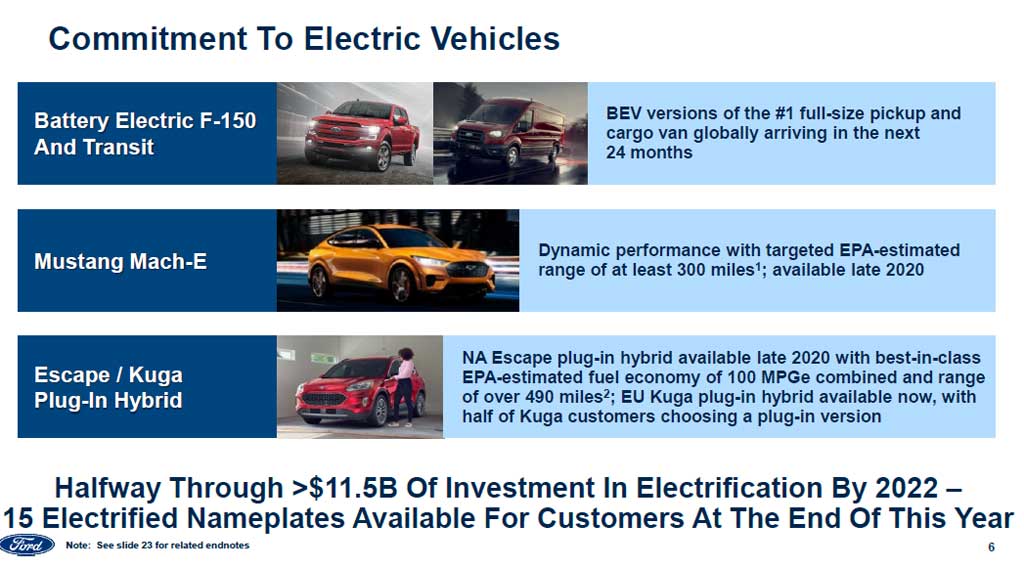
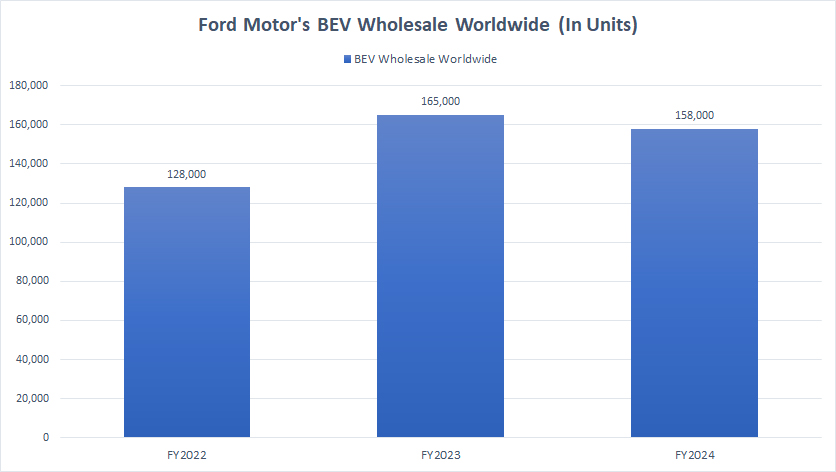
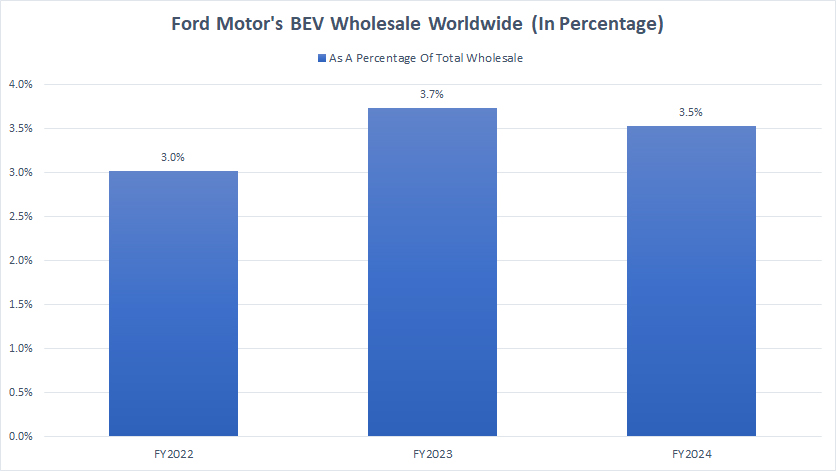
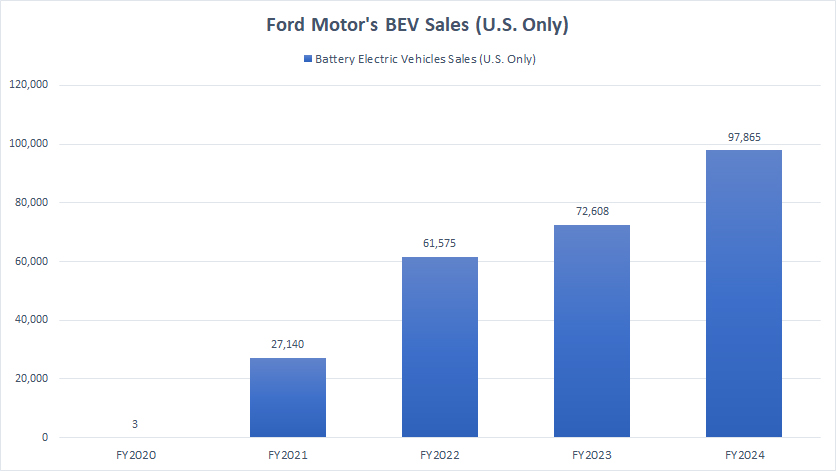
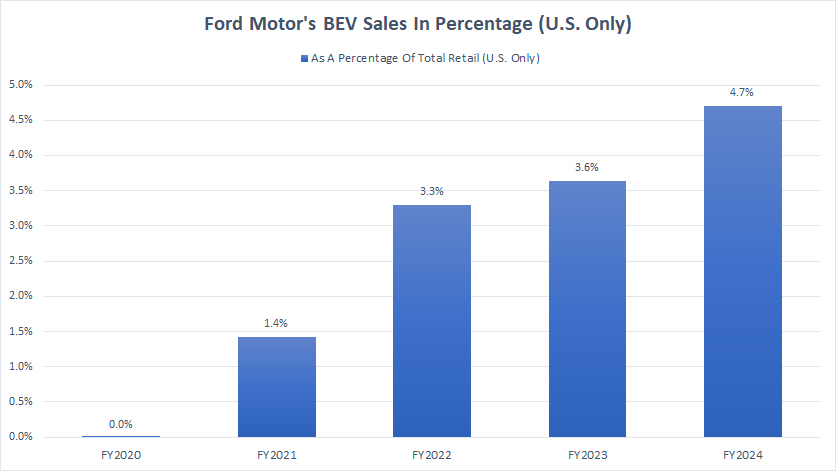
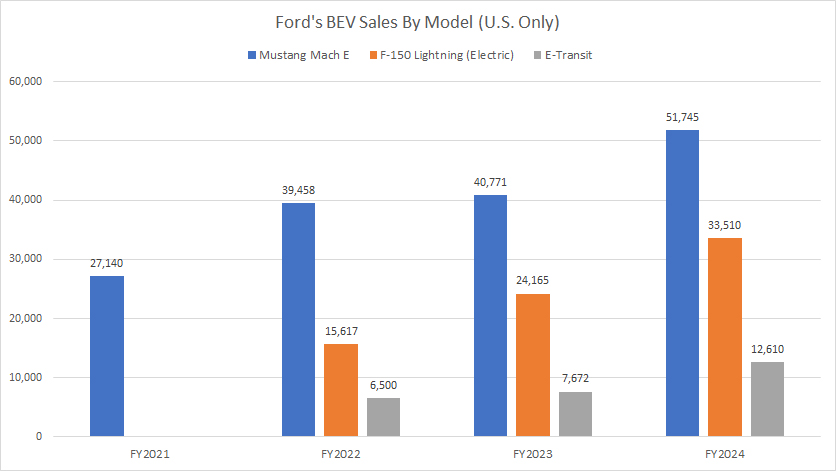
What about the Ford Focus Electric? I believe it’s all battery, not that they sold lots.
For whatever reason, Ford has ended the production of Ford Focus Electric in 2018, according to Wikipedia.
“Ford stated that initial production was limited but was ramped up in 2012. North American Ford Focus production ended in May 2018.”
Sure, but the article says Ford has sold 0 EVs and then basically zero. Wikipedia says they’ve sold over 9,000 of this one car. I assume there aren’t others but it makes me feel like I can’t trust this article at all now.
Don’t get me wrong I’m not a Ford supporter nor do I think they’re doing enough to electrify, but the statement seems misleading to me. Multiple times it says no EVs have been sold.
Thanks for pointing this out. I will made the necessary adjustment to the article.
My research on Ford’s electric vehicles has been based on the company’s latest filings and earnings releases.
It seems to me that Ford has only just started in terms of BEV roll out based on their latest earnings releases.
You also apparently neglected the fact that Ford sells the Mach E in Europe and China. You only counted US sales for Ford, but global sales for Tesla. Why would you do that?
Ford has sold about 200k Mach E alone, plus Lightning, plus E-Transit, plus a few Transit Connect EVs, plus some Ranger EVs.